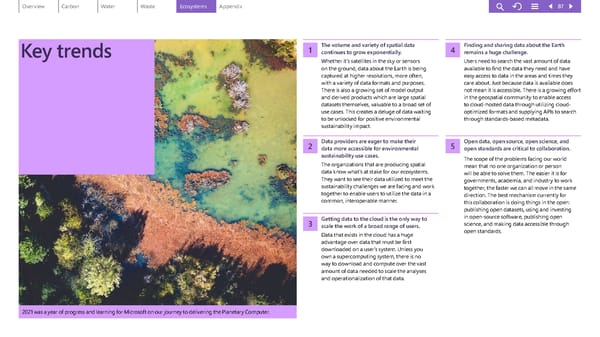Key trends 2021 was a year of progress and learning for Microsoft on our journey to delivering the Planetary Computer. 1 The volume and variety of spatial data continues to grow exponentially. Whether it’s satellites in the sky or sensors on the ground, data about the Earth is being captured at higher resolutions, more often, with a variety of data formats and purposes. There is also a growing set of model output and derived products which are large spatial datasets themselves, valuable to a broad set of use cases. This creates a deluge of data waiting to be unlocked for positive environmental sustainability impact. 2 Data providers are eager to make their data more accessible for environmental sustainability use cases. The organizations that are producing spatial data know what’s at stake for our ecosystems. They want to see their data utilized to meet the sustainability challenges we are facing and work together to enable users to utilize the data in a common, interoperable manner. 3 Getting data to the cloud is the only way to scale the work of a broad range of users. Data that exists in the cloud has a huge advantage over data that must be first downloaded on a user’s system. Unless you own a supercomputing system, there is no way to download and compute over the vast amount of data needed to scale the analyses and operationalization of that data. 4 Finding and sharing data about the Earth remains a huge challenge. Users need to search the vast amount of data available to find the data they need and have easy access to data in the areas and times they care about. Just because data is available does not mean it is accessible. There is a growing effort in the geospatial community to enable access to cloud-hosted data through utilizing cloud- optimized formats and supplying APIs to search through standards-based metadata. 5 Open data, open source, open science, and open standards are critical to collaboration. The scope of the problems facing our world mean that no one organization or person will be able to solve them. The easier it is for governments, academia, and industry to work together, the faster we can all move in the same direction. The best mechanism currently for this collaboration is doing things in the open: publishing open datasets, using and investing in open-source software, publishing open science, and making data accessible through open standards. 87
 Environmental Sustainability Report | Microsoft Page 86 Page 88
Environmental Sustainability Report | Microsoft Page 86 Page 88